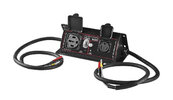BigWaylon
Head philatelist
Staff member
2A Bourbon Hound 2024
2A Bourbon Hound OG
Charter Life Member
Benefactor
Supporting Member
Multi-Factor Enabled
I have my eye on something, but don’t actually know when I’d ever use it. So I’ll explain a little and if anybody thinks of a situation I’d use it, please share.
I have two of the 3000/3500 HF Predator Inverter generators. I have two outlets wired to my house, so that I can hook them both up and basically run my whole house except for 240V (220, whatever the correct term is). That means I’m just out A/C, oven and electric dryer.
Plenty other options to cook with, gas heat and hot water, and multiple drying racks. Have an attic fan, five ceiling fans, a window unit A/C and a portable A/C. So far, never really had an issue without power being out.
But I’ve always been disappointed HF only offered a parallel kit for dual 2000W generators, and not for the 3500W model. Years ago they said it was coming, and nothing. Happened to check recently and they now exist.

 www.harborfreight.com
www.harborfreight.com

You end up with a 50A RV outlet, but everything is still 120V. Mine do come with RV adapters, but I don’t have an RV.
I can’t come up with a scenario when having one 50A 120V outlet would be used. I’d obviously still have both generators there, so why not just have two 30A sources? I have homemade cords that plug in to them and give me six outlets each, should I need them.
The whole reason I originally bought two was to put one on the back deck and one in the garage (with the door open) and run extension cords as needed. Or if my mom’s power was out I could loan her one to keep fridge/freezer alive. I’ve even taken to her house to power an electric turkey dryer at Thanksgiving.
They’re really quiet, and having two is kinda handy. Yeah, it would be nice to have one 12,000 and run the whole house, but that’s not the route I took.
So…anybody think of a scenario I’m missing where the parallel kit would be useful? It’s only $70, but I’m not sure I’d ever use it.
I have two of the 3000/3500 HF Predator Inverter generators. I have two outlets wired to my house, so that I can hook them both up and basically run my whole house except for 240V (220, whatever the correct term is). That means I’m just out A/C, oven and electric dryer.
Plenty other options to cook with, gas heat and hot water, and multiple drying racks. Have an attic fan, five ceiling fans, a window unit A/C and a portable A/C. So far, never really had an issue without power being out.
But I’ve always been disappointed HF only offered a parallel kit for dual 2000W generators, and not for the 3500W model. Years ago they said it was coming, and nothing. Happened to check recently and they now exist.

RV Ready 50 Amp Inverter Generator Parallel Kit
Amazing deals on this 50Amp Inverter Generator Parallel Kit at Harbor Freight. Quality tools & low prices.

You end up with a 50A RV outlet, but everything is still 120V. Mine do come with RV adapters, but I don’t have an RV.
I can’t come up with a scenario when having one 50A 120V outlet would be used. I’d obviously still have both generators there, so why not just have two 30A sources? I have homemade cords that plug in to them and give me six outlets each, should I need them.
The whole reason I originally bought two was to put one on the back deck and one in the garage (with the door open) and run extension cords as needed. Or if my mom’s power was out I could loan her one to keep fridge/freezer alive. I’ve even taken to her house to power an electric turkey dryer at Thanksgiving.
They’re really quiet, and having two is kinda handy. Yeah, it would be nice to have one 12,000 and run the whole house, but that’s not the route I took.
So…anybody think of a scenario I’m missing where the parallel kit would be useful? It’s only $70, but I’m not sure I’d ever use it.

